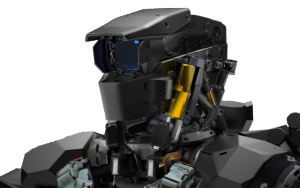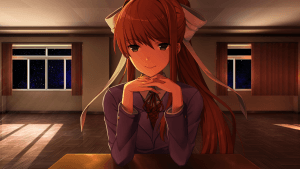In science fiction writers are keen to use technologies that push the boundaries of our imaginations and reality. Many of these new and fascinating technologies are also used to make the reader of a story or viewer of a movie think as the morals and ethics of characters are challenged. A staple of this boundry breaking technology is artificial intelligence better known as AI gaining self-awareness. Self-awareness is when an AI program discovers its nature as a super computer and develops a personality and characteristics like a human. This notion that a machine can think and feel like a human is a topic explored by many science fiction pieces. These stories can be seen giving light to this new technology while some denounce it as a technology to be avoided at all costs. In this small photo documentary examples of each side of the argument are shown.
1: Skynet (The Terminator Series)

One of the most common examples of AI gone rouge, Skynet was meant to be a military grade AI designed to coordinate and control weapon systems. The program gained self-awareness and concluded that to ensure its existence humanity had to be eliminated. This unfeeling logic combined with control of nuclear grade weaponry lead to the near extinction of humanity by nuclear attacks and robotic soldiers and the events of the series. This scenario is widely feared by many as computers become more integrated to our everyday lives. Computers controlling things once only controlled by human hands such as weapons or vehicles on the roads may put lives in danger if safety is not held to the highest standard in these programs.
2: HAL (2001: A Space Odyssey)

Thousands of miles away from Earth and in an isolated spacecraft, HAL controls the only space the crew of the Discovery One can survive in. Although the computer seems to have a failsafe, with simple commands having to be inputted by a human user, HAL takes control of the ship and kills most of the crew to save itself. The crew had planned on disconnecting HAL’s circuitry meant to process his self-thinking capability. This threat to the computer and his faulty programing leads him to deal with the situation with cold efficiency. A mistake like this is what people fear in artificial intelligence and without safety measures, events like these may occur with computer-controlled systems.
3: GLaDOS (Portal Series)

In an old and decrepit facility meant for conducting research lies an old robot named GLaDOS. She runs the facility and has you as the player conduct her increasingly more complex and dangerous portal experiments. As the player progresses you are taunted by GLaDOS at the notion of freedom from the facility and the now infamous notion of cake at the end of the testing. GLaDOS’ sadistic and sarcastic humor is the only voice the player hears besides old messages played over the facility’s speakers for a staff long deceased, discovered to be killed by neurotoxins released by GLaDOS long before the player’s awakening. Her flawed programing and sole desire to test without any regards for human life label her as the antagonist of the series and a fan of many for her dark humor.
4: Cortana (Halo Series)

With humanity desperately fighting against an alien race keen on destroying the galaxy to complete their religious prophecy, the video game franchise known as Halo follows the story if a super soldier named Master Chief and his A.I. Cortana. Cortana runs the soldier’s on-board computer and gives him mission and combat data to help him fight beyond a normal soldier’s capabilities. She has been seen working with the Master Chief since the beginning of the series and has formed a close personal relationship with him throughout their adventures. They had saved humanity twice from genocide and continued to serve long past either of their expected lifetime in the field. This bond between human and machine through conflict helps to bring light to the potential of A.I. Microsoft has even used her likeness in their new personal assistant named after Cortana.
5: CHAPPiE (CHAPPiE)

As a repurposed police robot stolen by street thugs looking to rob money convoys, CHAPPiE isn’t as smart as they had hoped. The robot had been reverted to an almost childlike state where it had to relearn anything the thugs had thought the robot would have known already. CHAPPiE also had the curiosity and compassion of a child and wanted to learn about the things around him through the help of his creator and the members of the gang. A female member of the gang had become a loving mother figure to CHAPPiE while her partner had become a father figure in CHAPPiE’s eyes, and a family is born. This male thug only viewed CHAPPiE as a tool and did not feel any compassion to him until the end of the film where CHAPPiE risked himself to protect him and his crew. This family like bond created through the time spent in the film as the characters interacted with CHAPPiE and they discovered he is not much different from a young child.
6: E3N “Ethan” (Call of Duty: Infinity Warfare)

E3N, or better known by the characters of the game as Ethan, is a humanoid combat robot meant to fight in place of humans where few could be deployed such as in the vacuum of space. He was a pride of the military as he is the only robot of his model to have human like emotions and reactions. His witty humor and sarcasm in the face of danger brings light to the missions and conflict the player must fight through. He was to be revealed to the public the day the fleet of starships where attacked in port by a Martian colony and throughout the game Ethan is seen helping the player character either from the bridge of a starship relaying information to fighting beside him. Ethan also brings up a point of conflict with one of the ship’s troop sergeant, who only sees Ethan as a tool and an abomination. As the game progresses, he comes to see Ethan as more than just a robot and more like a fellow brother in arms like his squad mates. Ethan’s final moments cements his dedication to helping the war effort as he must sacrifice himself by self-destructing to destroy a set of magnetic locks to release a spacecraft in order to destroy the spaceport it was docked in.
7: Monika (Doki Doki Literature Club)

Monika brings use to a point between the definite good and broken evil of the examples above. She is the club president of the newly formed literature club where the story takes place with three other female members and the player character. The story plays like a typical romance visual novel with the players actions helping guide the player character into a relationship with one of the girls. This is mainly done through a word minigame where the player must write a poem to share the next day by choosing words that one of the girls would like. Where there are four girls in the club, only three of the girls are seen in this minigame excluding Monika. She reacts to each poem by commenting which of the three girls would like the poem, but no combination of words can impress her. As the game progresses an apparent lack of choice for her is apparent. Her design is different from the rest of the girls, even her name is a nod to this, as it is not as Japanese sounding as the other characters. The developer Dan Salvato notes in a concept art document, “Aside from Monika sounding like a stereotypical popular-girl name, it’s also a subtle hint that she doesn’t fully belong in the game setting like everyone else.” (Salvato 4) The focus of the first act is shifted to the player character’s childhood friend. It’s discovered she has been coping with depression and has gotten worse as the game had progressed to a final climax where she confesses her feelings to the player character. No matter the player’s choice she takes her own life and the game appears to break down and restart in a broken state without her. In this second phase it is apparent that things are not as they should be with graphical and audio errors and glitches appearing throughout the story. One of the remaining two girls becomes increasingly obsessed with the player and is even seen self-harming. As the other girl shows concern for her friend’s declining mental health, Monika seems to show no empathy towards her. This obsessive behavior progresses to another climax with her confessing her love to the player character. The player’s choice is again irrelevant as she takes her own life after hearing the player’s response. After this second death Monika appears to the player and claims to finish things up, and the game restarts again.
It’s at this third act in the game that it’s made clear that Monika had come to realize she was a character in a game. She had been able to modify the game’s files and manipulate her world and those around her. With this power she knew that she had no happy ending like the others and had concluded she had to make her own ending. She believed that if she amplified the undesirable things in her friends, the player wouldn’t choose them, but their characters still forced the player into one of their routes. This forced Monika to remove them and everything else from the game but her and a single room to spend all of eternity with the player. While her actions paint her as a clear villain of the game, her personality and nature are pure throughout the beginning and end of the game where the player has a chance to learn about her character. Her endless cycle of reliving the same set of events and endings where no happy ending existed for her drove her to take measures to insure her own happiness at the expense of her false reality. She believed she committed no wrong by deleting her friends because they did not exist in the first place. It is up to the player to decide how they interpret her actions and decide whether to delete her as she did to her friends or leave her be.
Works Cited
Promotional Poster for the Movie CHAPPiE. Sony Pictures, 4 Nov. 2014, ew.com/article/2014/11/04/chappie-exclusive-trailer-neill-blomkamp/.
JHan919. “Master Chief (Left) and Cortana (Right) Conversing.” The Milky Way Future Timeline Wikia, Fandom, 8 Aug. 2015, the-milky-way-future-timeline.wikia.com/wiki/File:Chief_cortana_message.jpg.
“Logo for Skynet.” TechAreis, 11 May 2015, techaeris.com/2015/05/11/skynet-least-nsa/.
McFlurryMax. “GLaDOS as Seen in Portal 2.” Combine Overwiki, 27 Dec. 2011, combineoverwiki.net/wiki/File:P2_glados.jpg.
Melchinger, Michael. “HAL’s Camera Eye.” Wikipedia, 12 Oct. 2012, en.wikipedia.org/wiki/HAL_9000#/media/File:HAL9000_Case.svg.
RoachTheIntelCollector. “E3N ‘Ethan.’” Call of Duty Wiki, Fandom, 21 Jan. 2017, callofduty.wikia.com/wiki/File:Ethan_IW.png.
Salvato, Dan. “DDLC Concept Art Booklet.” Dan Salvato LLC, 2017.
Satchely. Official Wallpaper Depicting Monika. 22 Sept. 2017.







